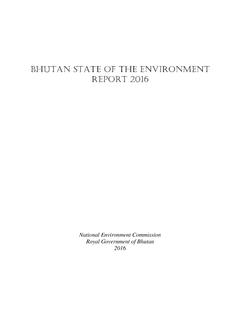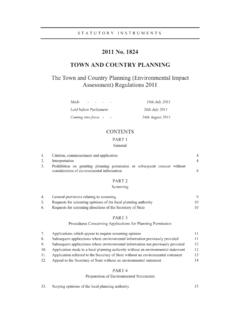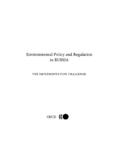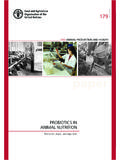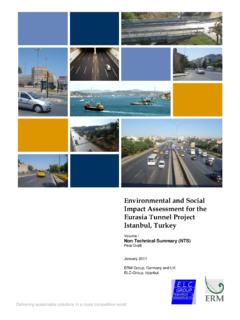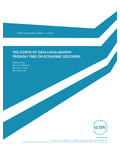Transcription of ENVIRONMENTAL ASSESSMENT GUIDELINE FOR ROADS …
1 May 2012. ENVIRONMENTAL ASSESSMENT . GUIDELINE FOR ROADS AND HIGHWAYS. National Environment Commission Royal Government of Bhutan Box 446, Thimphu : Bhutan Tele: 00975-2-323384/324323 Fax: 00975-2-323385. National Environment Commission Royal Government of Bhutan Printed @ Phama Printers & Publishers ENVIRONMENTAL ASSESSMENT . GUIDELINE FOR ROADS AND HIGHWAYS. May 2012. Foreword In 1999, the National Environment Commission published six sectoral ENVIRONMENTAL ASSESSMENT guidelines for the mining, ROADS , industries, hydropower, power transmission lines and forestry sectors. These guidelines were intended to guide different project proponents through the process of acquiring an ENVIRONMENTAL clearance for their projects. These sectoral guidelines were later revised in the year 2003 to make them more practical and relevant to the Bhutanese context and also to streamline with the provisions of the ENVIRONMENTAL ASSESSMENT Act 2000 and its Regulation 2002.
2 The revised sectoral guidelines of 2003 have played a very instrumental role in guiding the proponents and the sector agencies in the Environment ASSESSMENT (EA) process. However, these sectoral guidelines were long overdue for revision and through the World Bank IDF grant the guidelines were revisited and proposed for revision. All the relevant stakeholders were consulted several times for this revision and through the expert input from both local and international consultants the guidelines were revised to align with the changing government policies and rules and with the long-term objectives of protecting our pristine environment. The NEC is grateful to the World Bank for their financial assistance to revise and update these guidelines .
3 The revision and updating of these guidelines were accomplished through close consultation with all the relevant stakeholders. We would also like to express our gratitude and appreciation to all the ministries and stakeholders for their active participation, support and inputs. The NEC would also like to thank the team from the Centre for Science and Environment, New Delhi for their hard work and inputs in updating these guidelines especially Mr. Chandra Bhushan, Mr. Sujit Kumar Singh and Ms. Swati Singh Syambal. We are confident that the revised guidelines will be more useful documents that facilitate and expedite the ENVIRONMENTAL clearance process. The ENVIRONMENTAL ASSESSMENT process endeavors to mitigate and prevent undesirable impacts of developmental activities.
4 It is in no way intended to hamper socio-economic development in Bhutan but to guide project proponents and sector agencies in making right investments in land, manpower, technology and mitigation measures to ensure that their projects have the least possible impacts on the environment. It's the sincere wish and hopes of NEC that all the stakeholders' make the best use of these guidelines , which in turn will help in protecting our fragile ecosystem. Sound implementation of these guidelines will go a long way in minimizing the negative impacts of developmental activities on Bhutan's environment. Dr. Ugyen Tshewang Secretary, NEC. Contents Chapter 1: An introduction to the road and highway sector .. 1. Background .. 1. An introduction to ENVIRONMENTAL Impact ASSESSMENT (EIA).
5 2. Generic steps in the EIA process .. 2. Good practices in EIA .. 5. ENVIRONMENTAL and socio-economic impacts of the road and highway 6. Impact on land, air, water and noise environment .. 7. Impact on biodiversity .. 11. Impact on socio-economic environment .. 12. Chapter 2: Scoping .. 13. Introduction .. 13. Terms of Reference (ToR)for road /highway projects .. 13. General information .. 13. Essential maps for EA of 15. Project description .. 15. Activities for site preparation .. 18. Information on technologies and resource 19. Baseline data .. 19. Impact ASSESSMENT .. 21. Mitigation and ENVIRONMENTAL Management Plan (EMP) .. 22. Chapter 3: Impact ASSESSMENT .. 25. Introduction .. 25. Impact identification .. 26. Impact prediction.
6 26. Impact evaluation .. 29. Chapter 4: Mitigation and ENVIRONMENTAL Management Plan (EMP) .. 31. Introduction .. 31. Mitigation measures and EMP .. 33. Chapter 5: Review of an EIA report for a road /highway project .. 40. Introduction .. 40. Composition of the EIA review team .. 40. Reviewing an EIA report of a road /highway project .. 41. List of Tables Table Potential ENVIRONMENTAL and socio-economic impacts on the land, air and water environment 8. Table Quarry-related activities and potential ENVIRONMENTAL and social impacts 9. Table Impacts caused by road development projects on biodiversity .. 11. Table road location details by Dzongkhag and Geog . 14. Table road specification/quantities .. 16. Table Topography and observations along the road .
7 17. Table Parameters which determine impact characteristics .. 26. Table General models/methods used for impact prediction . 27. Table Mitigation measures and EMP for road /highway .. 33. List of Figures Figure Best practices in EIA .. 6. Figure Modifications in water table due to road construction activities .. 10. Figure Illustration of a chain reaction due to highway project .. 11. Figure Hierarchy of biodiversity mitigation measures .. 37. List of Boxes 1. Integration of EIA in the project cycle .. 4. 2. Impact evaluation criteria .. 29. 3. Possible evaluation criteria for determining impact significance .. 29. Forms / Checklists 1. Initial ENVIRONMENTAL Examination Form (IEE Form) Reviewer checklist for road /highway projects List of Abbreviations BAP Biodiversity Action Plan CA Competent authority CSE Centre for Science and Environment CSR Corporate Social Responsibility EA ENVIRONMENTAL ASSESSMENT EC ENVIRONMENTAL Clearance EIA ENVIRONMENTAL Impact ASSESSMENT EMP Environment Management Plan ETP Effluent Treatment Plant FDM Fugitive Dust Model HAPs Habitat Action Plans SOx Oxides of Sulphur NOx Oxides of Nitrogen CO Carbon mono-oxide NEC National Environment Commission NEERI National ENVIRONMENTAL Engineering Research Institute NGO Non Governmental Organisation NOC No Objection Certificate PAP Project Affected Population PM Particulate Matter R&R Resettlement and Rehabilitation Plan RoW Right of Way
8 SAPs Species Action Plan STP Sewage Treatment Plant ToR Terms of Reference CHAPTER 1. An Introduction to the road and Highway Sector Background ROADS in Bhutan are categorized as national highways, feeder ROADS , farm road and forest ROADS . Under the existing legal framework, all ROADS require ENVIRONMENTAL Clearance (EC) from the concerned authority. Apart from the ENVIRONMENTAL and social impacts, road and highway projects lead to better mobility, bring economic prosperity, creates facilities for uninterrupted traffic- flow with enhanced safety features including better road geometry and better traffic management. road and highway projects in most countries today require an ENVIRONMENTAL Impact ASSESSMENT (EIA) study before they are accorded ENVIRONMENTAL clearance.
9 This holds true for Bhutan as well. It is regulated under the ENVIRONMENTAL ASSESSMENT (EA) Act, 2000 and Regulation for ENVIRONMENTAL Clearance of Projects 2002. The EA Act and its Regulation establishes procedures for the ASSESSMENT of potential effects of strategic plans, policies, programs and projects on the environment, and for the determination of policies and measures to reduce potential adverse effects and to promote ENVIRONMENTAL benefits. According to the EA Act, ENVIRONMENTAL Clearance (EC) is mandatory for any project/ activity that may have adverse impact(s) on the environment. The Regulation for ENVIRONMENTAL Clearance of Projects 2002 defines responsibilities and procedures for the implementation of the EA Act concerning the issuance and enforcement of ENVIRONMENTAL clearance.
10 According to the legal framework, the National ENVIRONMENTAL Commission (NEC) is the nodal agency for administering and granting ENVIRONMENTAL Clearance (EC). The scope of the GUIDELINE is as follows: Provide guidance and assistance to various stakeholders involved in the EA process. Assist the regulatory agency and EIA practitioners to understand the main areas of concern and use that understanding to enhance the quality of the EIA study and report. 1. Inform the regulatory agency and EIA practitioners about the best ENVIRONMENTAL management practices in the highways and ROADS sector. Assist the regulatory agency to better assess the EIA report and arrive at a sound decision. An Introduction to ENVIRONMENTAL Impact ASSESSMENT (EIA).
